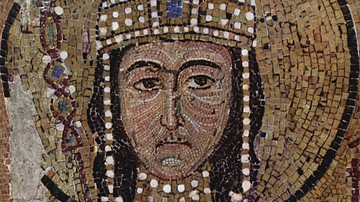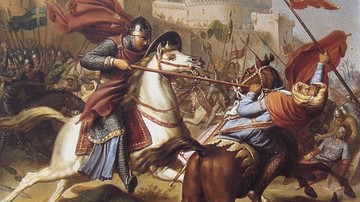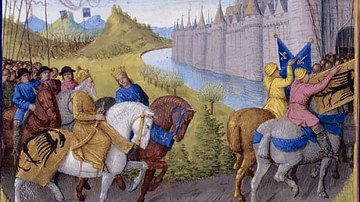
Alexios I Komnenos (Alexius Comnenus) was emperor of the Byzantine Empire from 1081 to 1118 CE. Regarded as one of the great Byzantine rulers, Alexios defeated the Normans, the Pechenegs, and, with the help of the First Crusaders, the Seljuks to put the empire back on its feet after years of decline. He would found the Komnenoi dynasty which included five emperors who ruled until 1185 CE. The emperor's life was recorded in the Alexiad, written by his daughter Anna Komnene.
Succession & Family
Alexios came from a military family from Asia Minor, and he had royal blood for he was the nephew of Emperor Isaac Komnenos (r. 1057-1059 CE). Alexios' father was John Komnenos, a senior military commander of the imperial guard (domestikos of the Scholai), and his mother, Anna Dalassena, was from a respected aristocratic family. In 1078 CE he married Irene Doukaina, who was distantly related to two former emperors and an ex-Tsar of the Bulgars. Alexios certainly had the pedigree to rise to the very top. He excelled in the army and rose to the position of general under Emperor Michael IV (r. 1034-1041 CE), never losing a battle.
Alexios, still a general but aged just 24, led a revolt against Emperor Nikephoros III (r. 1078-1081 CE) in 1081 CE after a series of damaging military defeats shrank the empire and threatened even the capital Constantinople. The economy was also stuttering with Nikephoros forced to devalue the gold nomisma, the main coinage of Byzantium. The aged Nikephoros saw the writing on the wall and abdicated, later retiring to a monastic life. Encouraged by his mother and backed by an alliance of powerful aristocratic families, Alexios took the vacant throne on Easter Day 1081 CE and made Anna, his mother, his chief advisor, granting her equal powers with himself in an imperial edict. Known for her piety, she was, nevertheless, as ruthless and able a politician as any male member of the court.
Alexios' eldest daughter, Anna Komnene, was for a time his official heir following her marriage to Constantine Doukas, the son of Michael VII (r. 1071-1078 CE). In 1087 CE Alexios had a son, John, who became his chosen heir. When Constantine Doukas died an early death, Anna married the gifted general Nikephoros Bryennios the Younger and plotted with her grandmother, Anna Dalassene, to make her new husband the next emperor, although this plan failed, largely because Nikephoros remained loyal to the official heir John. Alexios' eldest daughter turned out to be a historian of note, whose work on 11th-century CE Byzantium has become an invaluable source for her modern colleagues in that field. Her Alexiad covers the period 1069 to 1118 CE and is principally a tribute to her father. The work is the only such book written by a woman in the Middle Ages.
Military Campaigns
The Norman Invasion
The Byzantine Empire had been shrinking during the 11th century CE, but Alexios would oversee a string of victories against the peoples harassing the borders of his kingdom. The first group to be driven back and the most dangerous were the Normans. These descendants of Vikings, who had already conquered Byzantine territories in southern Italy between 1057 and 1071 CE, were led by Robert Guiscard (the “Crafty”), the Duke of Apulia. Robert, having betrothed his son to a daughter of Michael VII, was doubly dangerous as he could turn into a rallying point for disaffected members of the Byzantine court. Robert conquered Bari in 1071 CE, Palermo in 1072 CE, and Salerno, the last Lombard stronghold, in 1076 CE. In 1081 CE Robert and his son Bohemund became even more ambitious and attacked Byzantine Greece.
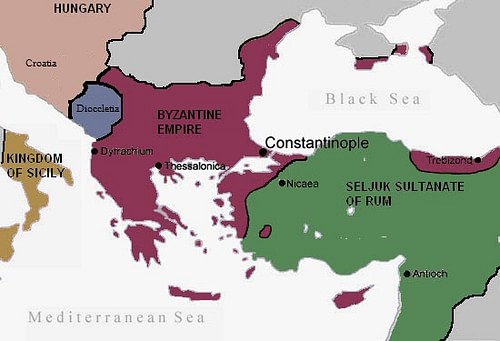
Alexios held the Normans back in 1082 CE despite defeats in the field and forced Robert to return to Italy to defend his interests at home. Alexios had been the crafty one and had signed a treaty of alliance with Robert's rival Henry IV, the King of the Romans, and paid a hefty fee in gold to Robert's nephew Abelard to raise a revolt in Italy. However, Bohemund continued with successes in Macedon and Thessaly, and Robert's return saw a resounding defeat of Alexios' Venetian allies in 1084 CE. Then the tide began to turn when the Norman army was hit by a devastating wave of typhoid fever in 1085 CE and Robert was one of its victims. Alexios then managed to retake Dyracchion (aka Durazzo), an important port in Dalmatia, and the Norman conquest of Greece collapsed.
The Pechenegs
Between 1085 and 1091 CE the northern frontiers of the empire saw similar incursions, in this case from the Pechenegs (aka Patzinaks), a nomadic people of the Eurasian Steppe. In past centuries the Pechenegs had served as mercenaries in the Byzantine army and been, on occasion, a useful buffer against the Bulgars and Rus, but in the mid-11th century CE they crossed the Danube and attacked Byzantine Thrace. They attacked Thracian cities again in 1087 CE, and in 1090 CE, they besieged Constantinople. The Pechenegs were joined by their allies, a force led by a former Seljuk commander, but neither could make any impression on the capital's famous fortifications, the Theodosian Walls. Alexios then responded by joining forces temporarily with the Cumans (the Turkish-speaking nomads from central Asia renowned for their archery skills) and inflicting a comprehensive defeat on the troublesome nomads on 29 April 1091 CE at the battle of Mount Lebounion. Resettling some of the defeated warriors, others were incorporated into the Byzantine army as mercenaries.
The First Crusade
Bohemund the Norman would turn up again in Byzantine affairs 12 years after his last encounter with Alexios, when he led the First Crusade which arrived in Constantinople in 1097 CE. Actually, it was Alexios himself who had invited mercenaries from the west to help him reconquer Asia Minor by writing letters to both Count Robert of Flanders and Pope Urban II - and come they did, albeit with the grander aim of retaking Jerusalem for Christendom. The first group to arrive in Constantinople was a rabble army led by Peter the Hermit. Pillaging and raping wherever they went, Alexios had them shipped off to Asia Minor as soon as possible where they met a predictably bloody end at the hands of the Seljuk army. The Seljuks were horsemen descended from a Turkish nomadic tribe, and they had formed the powerful Sultanate of Rum with their capital at Nicaea. The next wave of Crusaders to arrive in the East were a much more professional-looking group led by the finest knights and nobles of western Europe.
Initially, it seemed that the Normans and other Crusaders could usefully combine their forces with the Byzantine armies, Bohemund even swearing allegiance to the emperor along with the other Crusader leaders. Alexios used the Crusaders well, despite the rape and pillage perpetrated by the less pious members of the western armies which were causing chaos as they crossed Europe. Alexios may well have planned for a few new Christian kingdoms to act as a useful buffer on the empire's border, and so he directed them to free parts of Asia Minor from the Seljuks. With a mixed force of Crusaders, Alexios thus managed to recapture Nicaea in 1097 CE.
Antioch in Syria was the next big capture in June 1098 CE, but unfortunately for Alexios, on his way to support the siege he had met refugees from the area who wrongly informed him that the Crusaders were on the brink of defeat to a huge Muslim army and so the emperor returned home. Bohemund, not best pleased to find out his army had been abandoned by the Byzantines, decided to renege on his vow to return all captured territory to the emperor and kept the city for himself. The relations were thus irrevocably soured between the two leaders. Meanwhile, on 15 July 1099 CE, the Crusaders finally achieved their aim and Jerusalem was taken, the Muslim and Jewish inhabitants ruthlessly slaughtered.
The crises between the two halves of the Christian world deepened when the Normans headed back to Italy and began to plan for a Second Crusade, but this time against the Byzantine Empire whom western Christians always viewed with a healthy suspicion given their decadence and heretical religious practices. In 1107 CE the Normans, once more led by Bohemund, besieged Dyracchion. Bohemund's army was defeated, though, and the Norman leader was forced to sign the Treaty of Devol in 1108 CE, which effectively removed any Norman threat from Byzantine territory for half a century.
Trade Deals
Alexios' policies towards Venice would have significant consequences. In 1082 CE the Venetians were granted unrestricted trade across the Byzantine Empire, exemption from customs duties (10% of sales at the time), and even the odd warehouse and quay in Constantinople. This was in return for their crucial naval help in battling the Normans, but it would prove to be an overly generous act which hurt the Byzantine purse for decades to come and allowed Venice to develop a damaging stranglehold on trade in the East, thus establishing itself as one of the great naval powers of the Mediterranean. Similar concessions, albeit lesser ones (including a reduction of customs duties to 4%), were later granted to Genoa and Pisa whose fleets had been ravaging the Ionian coast.
Internal Affairs
Once he had taken over the leadership of the Romans, being always a man of action, he at once became immersed in matters of state…Alexios, the master of the science of government, directed all of his innovations towards the good of the Empire itself.
Alexiad (in Herrin, 235)
Things were not always tranquil at home for Alexios either, with a revolt springing up in 1095 CE. Led by Nikephoros Diogenes, the plot was quashed, and emperor's mother had the ringleader blinded. Alexios, understandably, reorganised the Byzantine court titles as part of his restructuring of the state bureaucracy where he mainly placed family connections whom he trusted in positions of power. Those aristocrats loyal to the emperor were awarded land and tax-collecting rights in the provinces. Alexios also used marriage alliances to great effect to unify the realm, notably joining the two great and often-feuding families of Komnenos and Doukas.
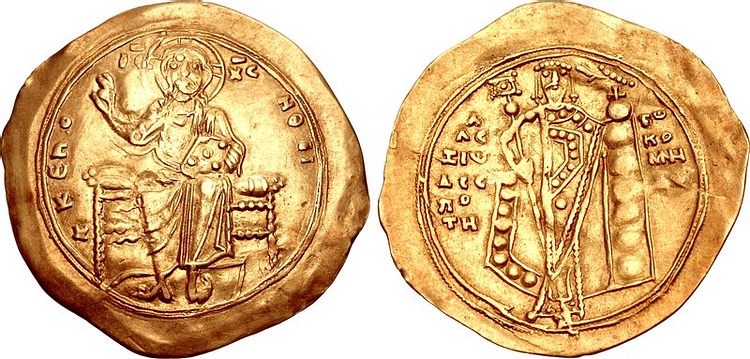
The emperor struggled to gain the necessary cash to pay the mercenaries he employed in his army, and for this reason, he melted down many Church valuables and raised taxes to four times their previous levels - payable in cash or labour. Compulsory military service was another unfortunate reality for much of the Byzantine peasantry. As part of his monetary reforms, a new coin was introduced, the hyperpyron (meaning “highly refined”), in 1092 CE. Made from electrum (a gold and silver alloy), it was worth one-third of the old standard gold nomisma, which had suffered under the fiscal policies of Alexios' predecessor. The hyperpyron became the new Byzantine coin standard against which all others were measured and valued until the 15th century CE.
Alexios was not shy about intervening in religious affairs, either. He re-established imperial control of the Church, reducing the power of the bishops, and he vigorously supported Orthodoxy, quashing any challengers to it. One notable group to be persecuted was the Bogomils which sprang up in Bulgaria renouncing all worldly affairs and proposing civil disobedience to its followers. Initially a movement aimed at Byzantine cultural imperialism, it spread across Western Europe and even to the heart of the Byzantine Empire. Alexios captured the Bogomil movement leader Basil - not so difficult considering they were pacifists - and had him burned to death in the Hippodrome of Constantinople.
Another target for Alexios' Orthodox zealousness was John Italos, the head of a school of philosophy in Constantinople. Considered a heretic for his Neoplatonism and picked out as a scapegoat warning for those who insisted on mixing philosophy and theology, John Italos was condemned in 1082 CE. On a more positive note, Alexios supported monasteries on Mount Athos in northern Greece and gave the island of Patmos in the Aegean to Christodoulos who founded the monastery of Saint John the Theologian in 1088 CE. The actual decree for this tax-free gift survives today in the monastery library archives.
Death & Successor
When Alexios died of disease on 15 August 1118 CE, his son John became emperor as John II Komnenos. One of his first acts was to banish his scheming sister Anna to a monastery, but at least this allowed her to write her Alexiad history in peace. John reigned until 1143 CE, and he would continue the military successes of his father with victories in the Balkans and Asia Minor. The historian T. E. Gregory here summarises the accomplishments of Alexios I Komnenos:
He rescued the Byzantine state from the threat of imminent dissolution. He faced a series of serious military threats, and, through a combination of diplomacy, personal cunning, and his own military ability, he generally emerged the victor. By the time of his death Byzantium was once again the most powerful state in the eastern Mediterranean. (298)

